How Queensland tennis star John Millman is coping with life in lockdown
The extraordinary lengths John Millman is going to to keep his tennis career on track after a terrific start to the year
QWeekend
Don't miss out on the headlines from QWeekend. Followed categories will be added to My News.
HE WAS able to out-muscle Roger Federer time and time again at the US Open to score one of the great tennis upsets of recent years but here, in his parents’ sunroom at Norman Park, in a leafy Queenslander surrounded by dense green foliage, John Millman is being constantly wrong-footed.
One of the most gracious and well-liked players on the world tennis circuit, he is staying with his mum and dad and their menagerie of rescue animals, at last count five cats, four dogs, two ducks and a black and white Polish chicken that has found a sunny home cradled between two armchairs.
‘He doesn’t understand’: Kyrgios slams $37m tennis star’s refusal to help lower-ranked players
Queensland wants NRL grand final even if crowds are still banned
Millman has risen from airport floors where he slept between tournaments as a battling, unrated pro, to become a thorn in the side of the world’s elite players. His reputation as a giantkiller is taking a battering on this afternoon though.
One of the dogs, a small, shaggy brown and white miniature collie named Harry, is constantly photobombing Millman and his parents, Shona and Ron, as they pose together on the couch for Qweekend. Try as Millman might to keep the dog off him, Harry is as relentless as Rafael Nadal on clay.
“My parents are very kind and loving people,” Millman says.
“My sister Bronte is a vet and Mum and Dad inherited most of these animals. They give them a very good life, a much better life than they had before.”
Coronavirus has forced Millman into the kind of break from tennis he has only ever known through career-threatening injuries. And with the Queensland Tennis Centre at Tennyson under lockdown, he has been hitting on backyard courts around Brisbane with as many good players as he can, trying to keep himself in some semblance of playing form for when tennis eventually resumes.

In March at Memorial Drive in Adelaide, Millman mounted a stirring comeback to steer Australia into the Davis Cup finals, coming from a set down to beat Brazil’s Thiago Monteiro after also fighting back from a set down in his opening rubber to beat Thiago Seyboth Wild.
“That is what Davis Cup tennis is all about,” Australia’s captain Lleyton Hewitt said at the time. “Johnny had to come out here and back up what he did yesterday – and what a performance. That is going to go down as one of the great weekends in his career.”
Millman went into the tournament as Australia’s top-ranked player in the absence of the injured Nick Kyrgios and Alex de Minaur.
He had hoped to continue that sparkling, fighting form in the lead-up up to another shot at the French Open and then Wimbledon this year, but instead is confined to backyard Brisbane tennis, riding his pushbike, or driving his dad’s car to the more distant courts to play anyone who’ll have a hit.
Having undergone two shoulder surgeries, groin surgery and more recently a foot injury and a torn calf, the enforced rest from the game must be doing the player – who turns 31 next month – some good?
“Not really,” Millman tells Qweekend, “at my age and with my history of injuries I wanted to keep playing because I was in good form and had a good rhythm. Obviously getting on top of the virus for the general population is the most important thing. But I can’t wait to start playing again.”
Still competitive in lockdown, the 183cm, 80kg Millman has also taken to riding an indoor bike, and throwing out challenges through an indoor cycling app, to keep the legs pumping like he did when he ran Federer into the DecoTurf at the 2018 US Open.
But here at his parents’ house there’s a languid pace as he starts sampling his mother’s biscuits.
A tortoiseshell Persian cat jumps onto the table and comes over to inspect the afternoon tea. Millman rubs his hand along the cat’s back.
“This is Belle,” he says. “She was found dumped in a bin across the road and Mum and Dad took her in.
“She actually had massive anxiety issues and was on medication. We never used to be able to pat her but she’s calmed right down. She’s a very lucky cat to get a start in this house.”
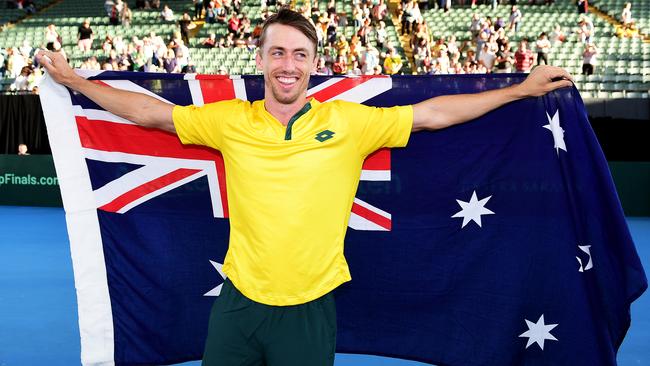
Encouraged by his parents, both high school physical education teachers, Millman played soccer as a small boy with the Wynnum Wolves.
Ron Millman had made his mark in football, playing 80 games in the National Soccer League and scoring 22 goals for the Brisbane Lions between 1979 and 1982. Against a touring AC Milan team in 1980 he headed a late equaliser for the Queensland state side at a packed Perry Park. His career was stymied by a broken leg but he still won the Rothmans Medal as the Player of the Year in the Brisbane competition in 1984.
Ron’s sisters, Joanne and Kerry Millman, were both part of the Matildas team at the 1988 FIFA Women’s Invitation Tournament in China, the forerunner of the FIFA Women’s World Cup.
John is the fourth of the five Millman children; his four sisters are Shona Jr, 37, Kara, 35, Tessa, 33, and Bronte, 26.
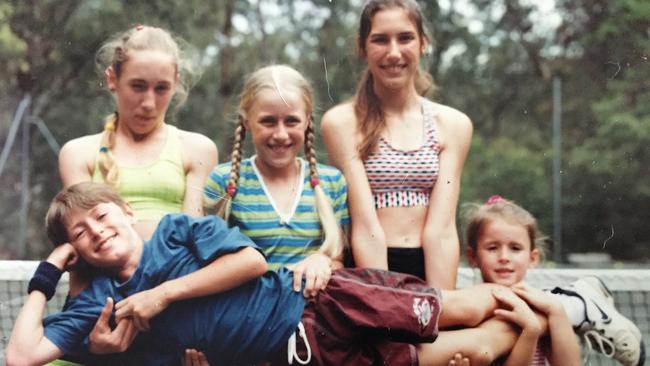
He says his tennis career began with 6am starts, dragging his racquet behind his older sisters for lessons at Laff’s Tennis Centre at Mount Gravatt. John’s grandmother, Hazel Millman, had courts alongside Norman Creek named in her honour for her fundraising efforts in Brisbane sport, and Kara and Bronte both played tennis for Queensland.
When Millman was 10, Australia beat Russia in a Davis Cup semi-final at Brisbane’s ANZ Stadium. Watching the Australian players Lleyton Hewitt and Wayne Arthurs shine made the little boy dream that one day he could represent his country, too.
Shona has one of Millman’s early report cards from Laff’s, signed by Ken Laffey, later a director of Tennis Australia. Millman makes a feeble attempt to grab the embarrassing document from his mum but the enforced isolation seems to have slowed his reflexes. Laffey noted of the seven-year-old hopeful:
“Forehand: Developing the shot.
Backhand: Turning the shoulders and hips before hitting.
Serve: Much better rhythm lately.”
And finally …
“Set play: Keep control over yourself … Keep focused, don’t cry and don’t lose it, even if it is hard out there.”
Advice Millman has remembered all his life.
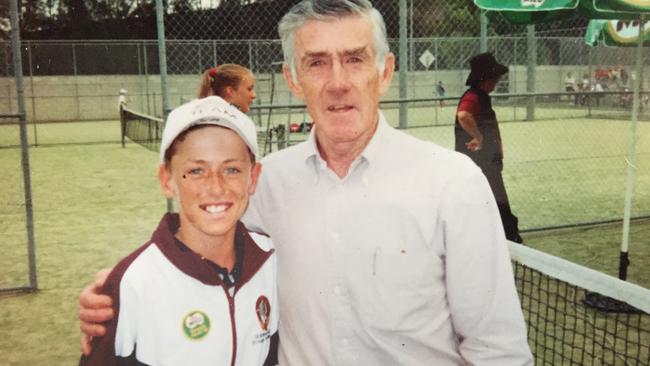
It’s centre court on Arthur Ashe Stadium at the US Open in New York, an hour past midnight on September 4, 2018 and Millman is staying focused even though it’s hard out there. The Swiss master Roger Federer outplayed him throughout the first set with his deft touch but the heat is cloying. Federer will say later that Millman comes from “one of the most humid places in the world, Brisbane” and he knew from the first point that it would be a long, tough night in their Round of 16 battle.
Millman had started the match in a white shirt but now he’s wearing black, dripping so much with sweat that it looks like someone has showered him with a hose. After a stuttering start Millman has taken two sets against one of the all-time greats and is now serving for the match in a fourth-set tie break.
Millman had lost all 10 of his previous matches when faced with someone in the world top 10. As he tossed the ball high to serve, after years of struggling through hard times to make a name for himself, he must have been nervous?
“I actually felt an enormous sense of calmness and clarity,” Millman says. “I served, we had a bit of an exchange and he hit it long and I just felt this great sense of relief. It wasn’t necessarily that I’d beaten the great Roger Federer, it was the fact that I had gotten close to the finish line and ran through it.
“The reality is that the top players only produce the ridiculously good form a couple of times a year. So I always prepare to face them in the belief they’re not going to have one of those days and that I can win.”
Interviewed immediately after the stunning loss, Federer said: “John played a great match in difficult conditions. I love his intensity.”
By reaching the quarter-finals, Millman collected $A662,000, more than double his earnings from the rest of the year, and many times his annual salary in the days when he was virtually paying to play. His world ranking rose from 55 to 37.
Watching on from courtside was his German girlfriend Fee Maeueler, a fashion marketer, who has been a big part of his life for the past four years. They met when she served him a coffee at the tennis centre her grandfather built in Stuttgart.
Millman played club tennis there, taking a weekly wage for a while because the prizemoney on the circuit was not enough to keep him in airfares and accommodation.
He now lives part of the year in the German city and the pair text or phone each other every day when apart.
Fee calls Millman “the most honest person I know” and he tells Qweekend: “Fee was very good to me when I wasn’t kicking too many goals and put up with a lot of the starts and stops in my tennis career. She’s been a rock solid support. That’s a great trait in someone.”
He thinks for a moment and then adds – “plus she’s got me on this German hair tonic that’s supposed to stop my hair loss.”
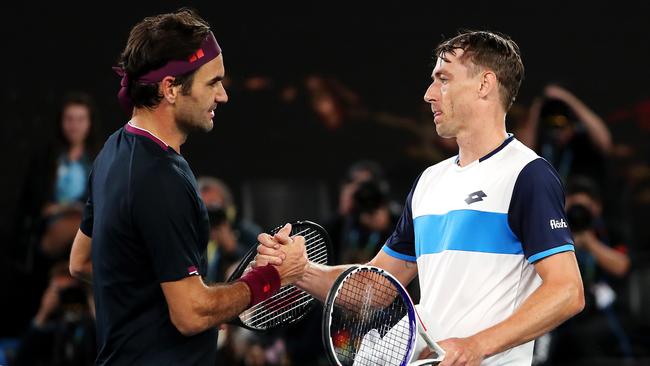
After beating Federer in 2018, Millman lost his next match at the US Open to the eventual champion that year, Novak Djokovic, who admitted that he “was very tested” and that Millman had staged “a great battle”.
Millman’s journey to Centre Court there was a long, tortuous one.
In the winter of 2003 Millman and another budding young tennis champ were staying warm, darting about a court on the Gold Coast, their skinny legs and arms pumping as they swung racquets almost as big as themselves.
Millman was playing Bernard Tomic, the German-born son of a volatile Croatian cabbie.
They put on a fierce battle at the Gold Coast Open Age Junior titles and the next day their local newspaper reported that 13-year-old Millman was too good for 10-year-old Tomic in the under-14 boys final.
At the time Ron and Shona became the live-in managers of the Carindale Tennis Centre so John could train there for long hours whenever he wanted.
He admits he initially questioned their insistence that he finish Year 12 at the Anglican Church Grammar School (Churchie), where he was a scholarship student, but says it gave him friends for life.
Still, it was Tomic whose career surged first. He became a multi-millionaire by his early 20s and was often seen driving a yellow Ferrari with the number plate “SINCITY” around the Gold Coast while Millman made do as a struggling professional, driving his dad’s clapped out Holden Astra when he was back in Brisbane.
For much of his career Millman was unable to afford a coach and travelled solo to far-flung corners of the globe, picking up cheques that often didn’t even cover his airfare at the back of the plane.
He recovered from shoulder surgery in 2007 to first try his luck at Wimbledon as a qualifier three years later.
“I thought it was a big deal,” he says.
“I go to rock up at the main gates at Wimbledon but I was told pretty quickly that qualifying was actually down the road at Roehampton on makeshift courts. The practice courts there were usually a soccer pitch complete with stud marks and the recovery centre was like a blow-up inflatable kiddie pool.
“Tennis can be a very glamorous sport but for most players it’s a hard slog with not much money. The expenses are enormous. You have to be ranked in the top 50 to really make a lot from the sport.”
Millman welcomes moves by Djokovic, Nadal and Federer to support struggling lower ranked professionals during the coronavirus crisis with suggestions that prizemoney from the ATP Finals and the Australian Open go towards a special relief fund.
He has long felt that the sport’s prizemoney is too top heavy, with hundreds of players just outside the elite rankings struggling to make a living.
Early in his career, as he dreamt of playing the big names on the centre courts of the Grand Slam events, he instead spent more time on airport floors – he remembers the ones at Barcelona and Frankfurt in particular – and the hard, irritating chairs that made makeshift beds in at least a dozen railway stations throughout Europe and Asia.
In 2012 he came back from seven months of injury to crack the world top 200 and finished only $12,000 out of pocket after slugging it out in gruelling matches around the world.
Playing the 2012 Futures circuit, the lowest rung on the professional ladder, was an experience he’s glad he left behind.
“I played at a place called Pitesti in Romania and I don’t think I saw a car the whole time I was there, only a few carts,” he says.
“I got food poisoning in Daegu in South Korea, which put me out for a week and then two weeks later I played another Futures tournament in Korea at Gimcheon.”
That tournament offered a total prize pool of $A15,000. By comparison last year’s US Open offered just on $A90 million.
“A lot of players in Gimcheon were pretty down about their career choices that week,” Millman says.
“No one would deliver food from the city out to our hotel so most of us would stay at the courts from seven in the morning to 10 at night and order pizzas because going back to the hotel was so depressing.
“I was watching an Aussie guy playing doubles at a really important stage in the match when this scooter drives straight up to the court and the rider walks out into the middle with his pizza boxes and tries to get the guy serving to pay. The player ended up double faulting and getting broken and he went absolutely nuts. It was that sort of place and that sort of tournament.”
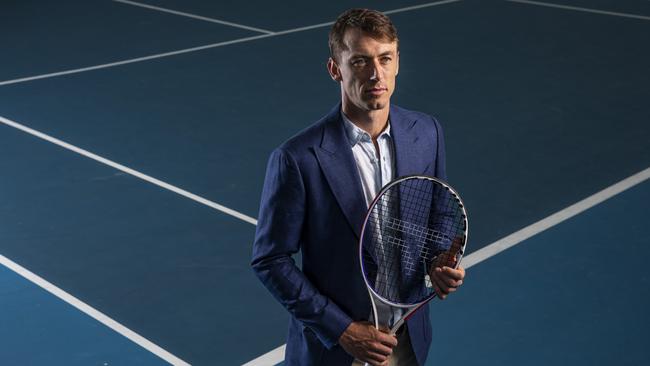
The following year Millman finally hit some winners. After fighting his way through qualifying on the outside courts at Tennyson he took a set off World No.3 Andy Murray in the 2013 Brisbane International. He played in his first Australian Open later that month but on the eve of the French Open when he would have earned at least $40,000 even if he lost in the first round, a shoulder injury forced him out of the game for more than a year.
His world ranking plummeted from 130 to 1193.
“At that level unless you win every tournament it’s actually costing you money to play,” he says. “If you go out in the first round in some tournaments you get a cheque for 140 bucks and you have to pay for flights and accommodation to get to the event.”
He fought back in August 2014, winning more Futures events in Korea, playing for peanuts as his peers were getting ready to play for millions at the US Open. He then headed to California to try to resurrect his standing in three Challenger events.
“I had six grand in my bank account and I had to fly over there and find a place to stay for three weeks. It was the last throw of the dice because if I didn’t win I’d probably have come home with nothing.
“But I did well and I got maybe $8000 or $9000 for the last tournament and probably $13,000 for the trip minus flights and expenses.
“The next year I was in the top 100 and I’ve been there ever since except for a week or two because of groin surgery at the end of 2016.”
Millman took a set off Federer at the 2015 Brisbane International and finally made it through the main gates of Wimbledon in 2015, after winning through the qualifying rounds. He toppled Spain’s Tommy Robredo in straight sets on debut upon the hallowed grass.
“It was on an outside court next to a temporary bar and people were getting really drunk and vocal,” he says. “A lot of Aussie expats came to watch.”
He was especially happy to see two of them.
“I got a bit of a payday so I flew Mum and Dad over,” he says.
“It was the least I could do for my parents, they’ve been such great supports for me. They never pushed me one way or the other with my tennis, they just wanted me to be happy and enjoy myself and that’s exactly what I’ve been doing since I started in the game.
“Money has never driven me too much. The last few years I’ve done pretty well and I’ve bought a couple of houses in Brisbane because I know it’s important to plan for the future. But money has never been my main motivation.
“You play tennis so you can walk through the gates and play on Centre Court at Wimbledon, so you can play Davis Cup, so you can play at the Olympics.
“They are special moments and thanks to this game I love I’ve been able to do them all.”
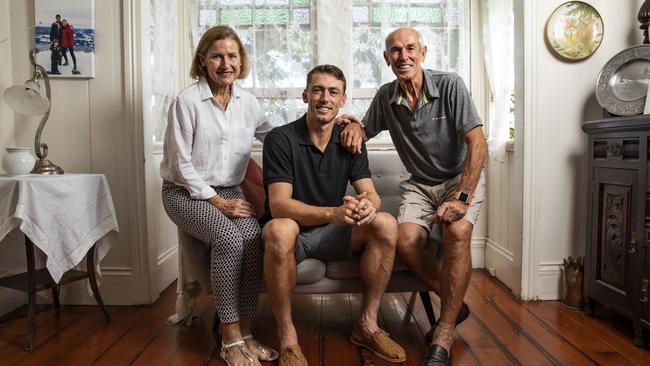
Millman defied a torn calf muscle to push Federer to the outer limits of endurance in one of the most memorable matches of this year’s Australian Open in Melbourne, leading 8-4 in their fifth set tiebreak only to have defeat snatched away as Federer took it 10-8. He is currently ranked 43 in the world and has been as high as 33. He hopes to rise even above that number when tennis resumes.
“I was playing really well this year and had a good summer,” he says, “Obviously it could have been a little nicer if I’d closed it out against Roger. If I’d won the match the draw would have opened up to put me close to a semi. I’d beaten Federer’s next two opponents, Marton Fucsovics and Tennys Sandgren, the last time I played them. So I hope to keep that momentum going for a while yet.
“Federer set a dangerous precedent in people’s minds that we can play until we’re 38 – but for me it’s probably only a couple more years.”
Millman says Federer is “nearly done” as a player. “Rafa (Nadal) still has a bit left and he is dominant on clay – I think Novak will finish with the most Grand Slams of all of them. He will still be around for a long time but the younger boys are starting to catch up.
“Daniil Medvedev is very good; Dominic Thiem’s good and Denis Shapovalov has so many weapons. I can see him winning a Slam.
“For me to get to that level I’d probably need to be 10 years younger and starting off again.
“Physically and mentally the game has never been tougher. You’re playing and travelling for 40 weeks a year and then you have to back up day after day.”
It’s an exhausting thought but Belle the cat closes her eyes as content as can be while Millman strokes her back.
“The thing I’ve always loved about tennis,” Millman says, “is the competition. The thing that carried me through all the hard times on hard floors, all the painful injuries and surgeries, was a burning desire to get the absolute best out of myself.
“There’s a lot of things you can’t control in tennis. A let court that goes against you; a ball that skims the line. But the one thing you can control is the amount of effort you put in.”
As a kid Millman dreamt of winning all the Grand Slams and being the best player in the world.
“I realised pretty quickly on the circuit that it might not quite work out that way,” he says.
“Maybe it didn’t all come true for me, but I’ve loved every minute of my time on the tennis court. And I’ve never stopped giving my very best.”


